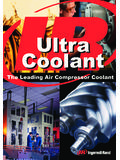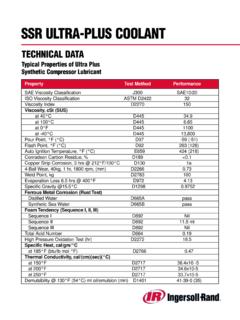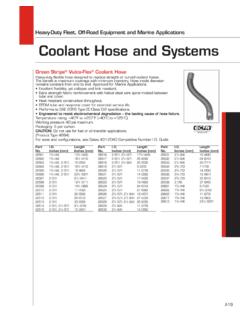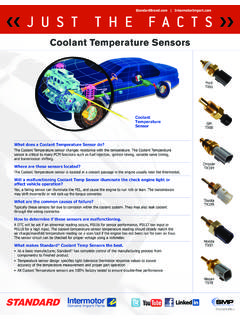Transcription of coolant can kill your engine - AA Gaskets 2017
1 The following article, by Joe Kenwright, appeared in the November, 1995 edition of WHICH CAR? Magazine, and is reproduced with permission from the publishers, ACM Syme. coolant can kill your engine your car s coolant can cost you thousands Instead of cooling and protecting, it can become mechanical poison capable of killing your engine before it has covered 100,000 km. It s a huge problem which may affect up to 90 per cent of Aussie cars, with ignorance and fast-bucks scams adding to the confusion. There is no law stopping someone from bottling coloured water and selling it as coolant . And because car companies use different materials and build engines with unique characteristics, a safe coolant in one car may cause damage in another.
2 There is also a growing trade in sub-standard coolants, including incentives for workshops to switch from reputable brands to unproven products. Up to 90 per cent of cars checked at some service centres contain coolant which provides little or no protection and will soon lead to serious engine damage. Blown head Gaskets are so common today they are an accepted part of motoring. Which car ? first heard of the coolant drama while researching used car problems, when persistent engine troubles in most cars made it clear there was more at fault than just individual design problems. Cars today are still described as water-cooled - apart from oddities like the air-cooled Porsche 911 - but plain tap water is the last thing you should put into a modern radiator.
3 Water cannot cope with the extra heat generated by anti-pollution engines or the anti-corrosion requirements of hi-tech engine materials introduced over the past 20 years. All car companies specify strict brews of anti-freeze, anti-boil and anti-corrosion chemicals - called coolant - to protect the engine and cooling system components for more than a decade. There is an Australian Standard for coolants - 2108-1984- but it won t stop a sharp operator filling a bottle with tap water and labeling it as coolant when there s no compulsory compliance. Which car ? has also discovered flaws in the administration of the Standard. Reputable companies may meet the AS2108-1984 Standard for coolants, but their credibility is reduced when it s too easy for unscrupulous operators to claim Standards compliance for coolant which does not comply.
4 Our researchers found there is no easy way for consumers to check whether the coolant complies - or whether the Standards sticker is genuine. A recent laboratory test showed more than 80 of 100 coolants sold in Australia did not meet the basic Standard. A comprehensive check with car companies also showed coolant which only meets the Australian Standard is usually not enough. There have been many technology changes since the Standard was introduced in 1984, so it is long overdue for an overhaul. The coolant situation has become critical today because of the latest developments in engine technology. Engines were made from thick and heavy-cast iron as late as 1985, with heavy radiators made from brass and lead, and used low-pressure, low-temperature cooling systems.
5 With untreated water they rusted internally but damage took much longer to show up when there was so much excess metal. And many of the problems developed slowly and did not stop the engine completely. The unusual problems were:- Radiator blockage from scale. Rotted Welsh plugs Worn water pump Weeping head Gaskets Lower operating temperatures and slow warm-up meant engines belched out more pollution - especially through heavy use of the choke - wore out more quickly and used more fuel . Passengers also had to suffer cold cabins and misted windows before the heater warmed up. But things are much different today, especially as modern engines have to do more work - air conditioning, power steering, big electrical systems - while using less fuel, polluting less and running better.
6 They have to heat up quickly to cut emissions, swallow and convert their own waste to cut pollution - which adds heat - and operate more efficiently. Modern drivers also demand their heater-demisters start working by the end of their street on even the coldest mornings, which means thin cooling walls and minimum cooling capacity for fast heat transfer from engine to coolant , heater core to cabin. It s all resulted in hi-tech alloy engine parts, aluminium and plastic composite radiators and heater cores, as well as lightweight engines with little excess material. Yet if their coolant loses its protective qualities, they can develop holes or cracks very quickly and have to be scrapped at big expense.
7 The rate of expansion and contraction in lightweight engine parts is huge, so car companies have had to develop special gasket materials which stay flexible and still seal. But bad or incorrect coolant will cause corrosion under these Gaskets which can break their seal, leading to catastrophic failure. In some cars the wrong coolant can eat away, perish or harden the Gaskets or seals with the same result. Common failures today include:- Head Gaskets and water pump seal failures. Holed Welsh plugs. Damaged cylinder liner seals. Cylinder head cracks and holes. Radiators, heater cores and other cooling system parts eaten away. A modern engine has a finely balanced, high-pressure cooling system with less coolant so it requires minimal time to heat up.
8 But it also must have the capacity to cool the engine on the hottest day while housed beneath the sleek and poorly ventilated bonnet of a modern car. So the engines coolant must be chemically stable not to vaporise or self-destruct at searing temperatures which can reach more than 150 degrees Celsius in some parts of the engine - straight water does not have a chance! The high pressures and temperatures in a modern cooling system will cause a blow-out as soon as there is any weakness. It s all become a big problem for the car s coolant , and for coolant manufacturers. A coolant must perform its anti-corrosive, anti-boil and anti-freeze functions without destroying the parts its meant to protect.
9 Glycol - the traditional chemical base for most coolants - on its own does not protect a cooling system from corrosion and might eventually contribute to it. It s still a vital component, but must be combined with anti-corrosive additives. The mixture must be used in proper proportions to do its job and has limited life after which it goes off chemically - which means no protection (at best) or eating away the engine s insides (at worst). coolant can also look clean - unlike rusty radiator water - after it has gone off chemically and is destroying your engine . The only safe way of monitoring coolant is sticking to recommended changeover times and distances. Another problem in modern, hot engines is the presence of highly corrosive bubbles - corrosive vapour - which form near the engine hotspots, including the cylinder liners and spark plugs.
10 They pound away at cooling system and engine components and can wear a hole through an unprotected cylinder head or radiator in less than 10,000km. Electrolysis between different metals within the cooling system can have a similar effect, not like traditional rusting but far worse. So coolant must have the right amount of anti-boiling agent to reduce bubbles and of corrosion inhibitors to form a protective skin throughout the cooling system. But it s only a matter of time before even the best inhibitors are worn away and this is one of the key reasons why most manufacturers prescribe short intervals for coolant changes. You ignore their advice at your peril. The Australian Standard for coolant requires at least 25 per cent ethylene glycol - some manufacturers require 30 - 50 per cent - but it s not cheap and neither are the corrosion inhibitors.








